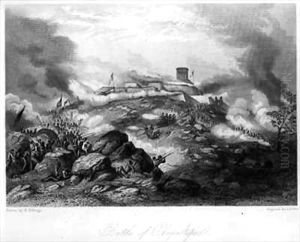Hammatt Billings Paintings
Charles Howland Hammatt Billings, known as Hammatt Billings, was an American artist and architect from the 19th century, recognized for his work as an illustrator, designer, and architect during a prolific career that spanned several decades. Born on June 14, 1818, in Milton, Massachusetts, Billings demonstrated a keen interest in the arts from an early age, which led him to pursue a career in the creative field.
Initially, Billings gained recognition as a talented illustrator. His most famous work in this capacity is likely his illustrations for the first edition of Harriet Beecher Stowe's seminal novel, 'Uncle Tom's Cabin', which played a significant role in shaping the public’s perception of slavery and contributed to the abolitionist movement in the United States. The power of Billings' images in 'Uncle Tom's Cabin' lies in their emotional impact and ability to communicate complex themes of injustice and humanity.
Beyond illustration, Billings was also an accomplished architect. He worked on a variety of projects including residential, commercial, and public buildings. One of his notable architectural contributions was his design for the original Boston Museum, which was one of the first buildings in the United States to incorporate a theater, a natural history museum, and a picture gallery in one facility. Though many of his architectural works have been altered or destroyed, they were influential during his time and contributed to the architectural landscape of the era.
In addition to his work on 'Uncle Tom's Cabin' and the Boston Museum, Billings also designed the Civil War monument in Concord, Massachusetts, and was involved in the creation of various memorials and statues. His versatility in working across different media, from print to stone, showcased his diverse skill set as an artist and designer.
Hammatt Billings' career declined in his later years, and he faced financial difficulties. He passed away on November 15, 1874, in Boston, Massachusetts. Despite the challenges he faced toward the end of his life, his contributions to American art and architecture remain significant. Billings' legacy is reflected in the lasting impact of his illustrations and the architectural works that continue to be studied and appreciated for their historical value.
